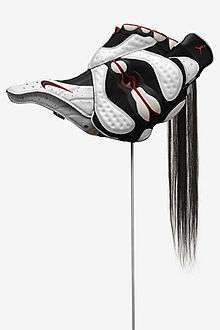Brian Jungen
| Brian Jungen | |
|---|---|
 Prototype for New Understanding #8, 1999 Nike athletic footwear, human hair | |
| Born |
April 29, 1970 (age 46) Fort St. John, British Columbia |
| Nationality | Canadian, Dunne-za |
| Education | Emily Carr Institute of Art and Design |
| Known for |
contemporary art installation art |
| Notable work |
Prototypes of New Understanding (1998-2005)[1] Shapeshifter (2000)[2] Court (2004)[3] |
| Movement | found art |
| Awards |
2002 Sobey Art Award[1] 2010 Iskowitz Prize for visual arts[1] |
Brian Jungen (born April 29, 1970 in Fort St. John, British Columbia) is a Canadian artist from British Columbia with Swiss and Dunne-za First Nations ancestry. He graduated from the Emily Carr Institute of Art and Design in 1992 and is based in Vancouver.
Artistic approach
Jungen's art draws upon the tradition of "found art", espoused by such twentieth-century artists as Andy Warhol and Marcel Duchamp. Instead of presenting objects "as-is," however, Jungen often reworks them without fully concealing their original meaning or purpose. For instance, Jungen's series Prototypes of New Understanding (1998-2005)[1] consists of aboriginal masks assembled and hand-sewn from parts of Nike Air Jordan shoes. Jungen writes: "It was interesting to see how by simply manipulating the Air Jordan shoes you could evoke specific cultural traditions whilst simultaneously amplifying the process of cultural corruption and assimilation. The Nike mask sculptures seemed to articulate a paradoxical relationship between a consumerist artefact and an 'authentic' native artefact."
The Nike footwear that Jungen had employed incorporates in their unmodified forms similar colours to traditional First Nations artwork and wood carvings: red and black. However, other projects, such as a series of wooden pallets, painstakingly crafted out of red cedar, a First Nations tent made out of "11 leather couches" and Jungen's large "whale-bone" sculptures made out of plastic chairs (some still with Canadian Tire price stickers on them) seek to defamiliarize even members of Western society that are unfamiliar with First Nation themes by placing familiar objects in unfamiliar positions or situations and vice versa.
Yet other projects, such as Jungen's "Isolated Depiction of the Passage of Time," are more political. In this specific example, the plastic food trays are colour-coded to match the statistics of jail sentences given to First Nations individuals, while (inspired by a prison-break exhibit Jungen once saw), the inner part of the sculpture conceals a television and a DVD player, quietly playing the film The Great Escape from the inside.
In 2004, he participated in A Grain of Dust A Drop of Water: The 5th Gwangju Biennale in Gwangju, Korea. An exhibition of Jungen's work was held at the Vancouver Art Gallery (Canada) from January 28 to April 30, 2006. Later that year he also held an exhibition at the Tate Modern from May 20 to July 9, 2006. In 2008 he participated in the Sydney Biennale exhibiting his installation entitled Crux.[4]
Jungen is the first living Native American artist to exhibit at the Smithsonian's National Museum of the American Indian (NMAI) in Washington, D.C. with his survey exhibition entitled Strange Comfort that was on view from October 16, 2009 to August 8, 2010. Jungen won the 2010 Iskowitz Prize for visual arts.
In 2011, Jungen unveiled three public sculptures at the Banff Centre entitled The ghosts on top of my head, consisting of white powder-coated steel benches, each in the shape of an antler from an elk, moose, and caribou.[5]
His sculpture entitled Carapace was inspired by Jules Verne's mythical giant animals and was exhibited in Loire Valley, where Jules Verne is from. It was also shown at the Art Gallery of Alberta in Edmonton in 2011.[6] He grew up in an isolated community in the Peace River area in credits this with stimulating his creativity.[6] why did brian jungen create those masks?
Major collections
Jungen's work is in the National Gallery of Canada's permanent collection of contemporary artists.[1] Shapeshifter (2000) was acquired in 2001;[2] Court (2004) was acquired in 2012;[3] Star/Pointro (2011) was acquired in 2011;[7] People's Flag (2006)[8]
References and sources
- 1 2 3 4 5 Collections: Brian Jungen, Ottawa, Ontario, 2014, retrieved 5 March 2014
- 1 2 Collections: Shapeshifter, Ottawa, Ontario: National Gallery of Canada, 2014, retrieved 5 March 2014
- 1 2 Collections: Court, National Gallery of Canada, 2014, retrieved 5 March 2014
- ↑ Scott, Kitty (1 February 2010), Brian Jungen’s transformative art, Banff, Alberta: Banff Centre, retrieved 5 March 2014
- ↑ The ghosts on top of my head Brian Jungen
- 1 2 Sandals, Leah (20 February 2011), Questions & Artists: Brian Jungen, Edmonton, Alberta, retrieved 5 March 2014
- ↑ Collections: Star/Pointro 2011, Ottawa, Ontario: National Gallery of Canada, 2014, retrieved 5 March 2014
- ↑ Collections: People's Flag 2006, Ottawa, Ontario: National Gallery of Canada, 2014, retrieved 5 March 2014
Online exhibits and media
- The Tyee
- Cybermuse National Gallery of Canada.
- Artfacts.net
External links
- Fetishism, Curiosity, and the Work of Brian Jungen by Kimberly Phillips in Fillip
- Brian Jungen at Kadist Art Foundation